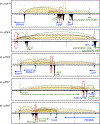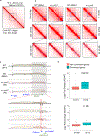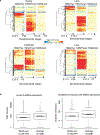Chromatin interaction analyses elucidate the roles of PRC2-bound silencers in mouse development
- PMID: 32094912
- PMCID: PMC7869692
- DOI: 10.1038/s41588-020-0581-x
Chromatin interaction analyses elucidate the roles of PRC2-bound silencers in mouse development
Abstract
Lineage-specific gene expression is modulated by a balance between transcriptional activation and repression during animal development. Knowledge about enhancer-centered transcriptional activation has advanced considerably, but silencers and their roles in normal development remain poorly understood. Here, we performed chromatin interaction analyses of Polycomb repressive complex 2 (PRC2), a key inducer of transcriptional gene silencing, to uncover silencers, their molecular identity and associated chromatin connectivity. Systematic analysis of cis-regulatory silencer elements reveals their chromatin features and gene-targeting specificity. Deletion of certain PRC2-bound silencers in mice results in transcriptional derepression of their interacting genes and pleiotropic developmental phenotypes, including embryonic lethality. While some PRC2-bound elements function as silencers in pluripotent cells, they can transition into active tissue-specific enhancers during development, highlighting their regulatory versatility. Our study characterizes the molecular profile of silencers and their associated chromatin architectures, and suggests the possibility of targeted reactivation of epigenetically silenced genes.
Conflict of interest statement
Competing Financial Interest
We declare that none of the authors have competing financial or non-financial interests.
Figures















References
-
- Cook PR A model for all genomes: the role of transcription factories. J Mol Biol 395, 1–10 (2010). - PubMed
Publication types
MeSH terms
Substances
Grants and funding
LinkOut - more resources
Full Text Sources
Other Literature Sources
Molecular Biology Databases

